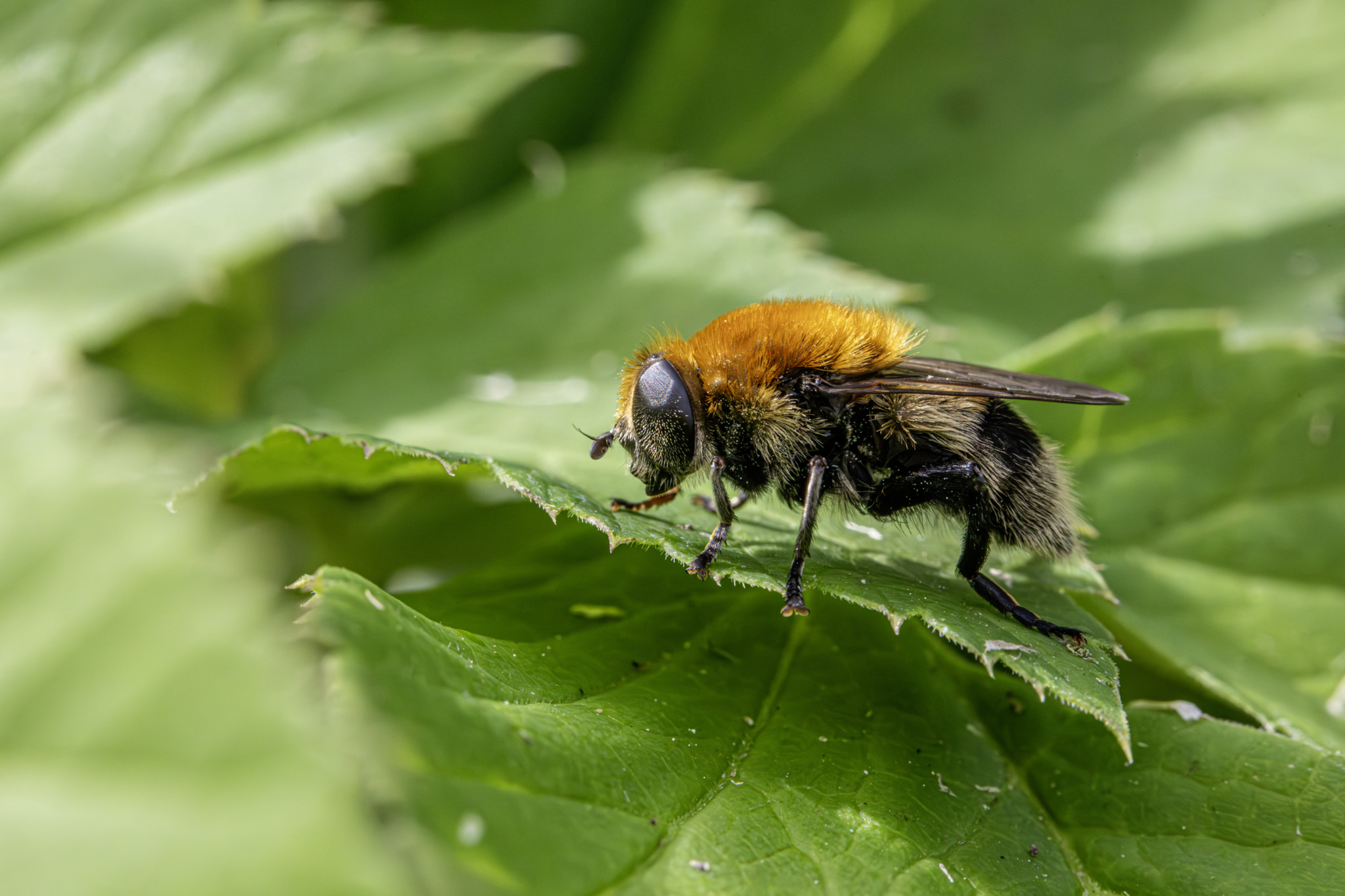The Greater Bulb Fly (Merodon equestris), also known as the Narcissus Bulb Fly, is a species of hoverfly that is known for its larval stage, which infests and damages bulbs of various plants, especially those of the genus Narcissus. Here are some detailed features and characteristics of the Greater Bulb Fly:
Appearance
- Size: Adult Greater Bulb Flies are about 12-14 millimeters in length.
- Coloration: Adults are typically yellow and black, mimicking bumblebees, which helps them avoid predators. They have a furry appearance similar to that of bumblebees.
- Body Structure: The body is robust and hairy, with a characteristic hoverfly appearance. The wings are clear with a slight darkening near the edges.
Habitat
- Preferred Habitats: Greater Bulb Flies are commonly found in gardens, parks, and areas where bulbous plants are cultivated. They are also found in meadows and open woodlands.
- Geographic Range: This species is widespread across Europe and has been introduced to other parts of the world, including North America.
Behavior
- Adult Feeding: Adults feed on nectar and pollen from a variety of flowers. They are often seen hovering around flowers in search of food.
- Larval Feeding: The larvae are the most damaging stage of this species. They feed on the bulbs of plants, particularly Narcissus, but can also infest tulips, hyacinths, and other bulbous plants. The larvae tunnel into the bulbs, causing extensive damage that can lead to rot and plant death.
Reproduction
- Mating: Adults mate in the spring and early summer.
- Eggs: Females lay their eggs on the soil near the base of host plants or directly on the bulbs.
- Larvae: The larvae, also known as maggots, hatch from the eggs and burrow into the bulbs. They feed on the bulb tissue, causing significant damage. The larval stage can last several months, after which they pupate in the soil.
- Pupation: Pupation occurs in the soil near the infested bulb. The pupal stage can last several weeks before the adult emerges.
Impact on Plants
- Damage: The feeding activity of the larvae can cause severe damage to the bulbs, leading to stunted growth, wilting, and death of the plants. Infested bulbs often show signs of rot and may not produce flowers.
- Signs of Infestation: Signs include holes in bulbs, yellowing or wilting leaves, and reduced flowering. Upon inspection, infested bulbs may reveal larvae or tunnels within the bulb tissue.
Control Methods
- Cultural Control: Practices such as rotating crops and removing and destroying infested bulbs can help reduce the population of Greater Bulb Flies. Planting resistant varieties or species that are not preferred by the larvae can also be effective.
- Biological Control: Natural predators and parasites, such as nematodes, can help control larvae populations. Research is ongoing to find effective biological control agents.
- Chemical Control: Insecticides can be used to manage Greater Bulb Fly populations, but they should be applied with caution to avoid harming beneficial insects and pollinators.
Interesting Facts
- Bumblebee Mimicry: The adult Greater Bulb Fly’s resemblance to bumblebees is an example of Batesian mimicry, where a harmless species mimics the appearance of a harmful one to avoid predation.
- Lifecycle: The lifecycle of the Greater Bulb Fly is closely tied to its host plants, and the timing of its development stages often coincides with the growth cycles of these plants.
- Invasive Species: In regions where they have been introduced, Greater Bulb Flies can become significant pests due to the lack of natural predators.
Identifying Merodon equestris
- Distinctive Features: The mimicry of bumblebees, with yellow and black coloration and a furry appearance, is a key identifying feature. The clear wings with slight darkening near the edges and the hoverfly body structure also help in identification.
- Behavioral Traits: Observing their hovering flight and feeding on flowers can aid in identification. The presence of damaged bulbs and larvae in the soil near the plants are signs of infestation.
In summary, the Greater Bulb Fly (Merodon equestris) is a hoverfly species known for its bumblebee mimicry and its damaging larvae, which infest and consume plant bulbs. Effective management includes cultural practices, biological control, and, when necessary, chemical treatments. Awareness and prompt action are essential to prevent and mitigate the damage caused by this pest.
Views: 16
Subscribe to the newsletter:
